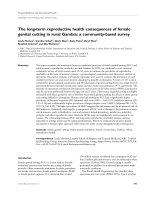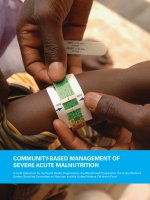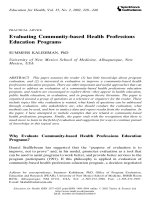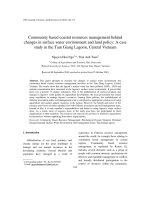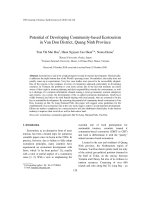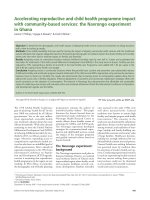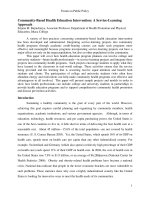Community based adaptation
Bạn đang xem bản rút gọn của tài liệu. Xem và tải ngay bản đầy đủ của tài liệu tại đây (306.96 KB, 4 trang )
briefing
briefing
briefing
Policy
pointers
n CBA or community-based
adaptation is increasingly
recognised as a key way for
the world’s poorest and most
vulnerable people to build
capacity to cope with the
impacts of climate change.
n In the runup to the
Copenhagen climate talks
in December 2009, lessons
learned from the growing
number of CBA case studies
can inform policy dialogue.
n To maximise CBA’s
influence, practical ways
of consolidating lessons,
sharing knowledge and
scaling the approach
up are needed, so it is
relevant to larger-scale
adaptation policymaking
yet does not compromise
the participatory and
community-driven nature of
the approach.
Coming of age: CBA gets organised
As an approach to building the resilience of the poor
to the impacts of climate change, community-based
adaptation has made significant progress in recent years.
At the Third International Workshop on CBA in February
2009 in Dhaka, Bangladesh, it was evident that the time
Over a billion people – the world’s poorest and most vulnerable communities – will
bear the brunt of climate change. For them, building local capacity to cope is a
vital step towards resilience. Community-based adaptation (CBA) is emerging as
a key response to this challenge. Tailored to local cultures and conditions, CBA
supports and builds on autonomous adaptations to climate variability, such as the
traditional baira or floating gardens of Bangladesh, which help small farmers’ crops
survive climate-driven floods. Above all, CBA is participatory – a process involving
both local stakeholders, and development and disaster risk reduction practitioners.
As such, it builds on existing cultural norms while addressing local development
issues that contribute to climate vulnerability. CBA is now gaining ground in many
regions, and is ripe for the reassessment offered here.
had come to reassess CBA — look at developments over
the past few years, and the challenges that remain.
Over 140 people attended this oversubscribed workshop,
a significant increase over previous years (see Backstory).
They included representatives from governments, NGOs,
community-based organisations, UN agencies, and major
donors including the World Bank, UK Department for
Download the pdf at www.iied.org/pubs/display.php?o=17064IIED
Community-based adaptation to
climate change: an update
JUNE 2009
Backstory
Community-based adaptation or CBA emerged out of
a growing recognition in the developing community
that those most vulnerable to climate change are the
poorest people in the world’s poorest regions. Many are
marginalised, and live in remote regions out of reach of
government services.
The usefulness of mainstream, top-down adaptation
approaches in these communities began to be
questioned. As a result, many agencies started to
work with local communities to identify not only
climate-related risks, but also factors that make people
vulnerable to those risks. The process was a first step
in developing community-driven initiatives that could
help build adaptive capacity in the most vulnerable
communities. As climate impacts progress, the need for
this effort is increasingly clear.
In 2005, agencies and others working on what was
now known as community-based adaptation came
together for the First International CBA Conference
in Dhaka, Bangladesh, to share experiences and
lessons. Here, more than 80 experts, policymakers,
NGO representatives and grassroots practitioners
discussed the possible impacts of climate change on
communities, and how to enable them to adapt in
the future. Experiences were shared, contacts made,
and the concept of CBA was firmed up. At the second
CBA conference in Bangladesh two years later, there
were 110 participants – practitioners, major donors and
representatives from the international climate treaty,
the UN Framework Convention on Climate Change
(UNFCCC). Field visits to vulnerable communities allowed
attendees to gain firsthand experience of the ‘entry
point’ for CBA. And what was now the CBA community
began to self-organise, for instance by creating the CBA
Exchange (CBA-X), an online platform for sharing tools,
case studies and guidance.
International Development (DFID), Swedish development
agency Sida, and the Food and Agriculture Organization of
the UN (FAO). The CBA Exchange – an online platform for
sharing CBA news, views and practice – was updated and
formally launched. Called CBA-X, the network now has
over 200 members and is expanding rapidly.
The workshop also saw the launch of
the Global Initiative on Community
Based Adaptation (GICBA). The
GICBA will reflect on ongoing
action by promoting CBA nationally
and globally; generate and share
knowledge and experiences; and
support the CBA-X website and international conferences.
This knowledge-sharing platform will be a forum focusing
on building CBA’s profile, collating and refining learning,
lessons and tools for how to do CBA. GICBA is supported
by IIED, CARE, Oxfam, ActionAid, TearFund and WWF.
Critical mass: firming up CBA
Recently, understanding and knowledge of CBA has
grown exponentially. At the second CBA workshop, the
task was to convince development practitioners working
with communities that climate change was relevant to
them, and that vulnerability to climatic variability was the
entry point for building adaptive capacity.
As noted by reports on that workshop, however,
discussions round CBA were ‘lacking in structure’. This
posed a problem for CBA practitioners, funding bodies
and others who require signposts to distinguish
good practice.
1
The report of the third CBA workshop notes the exchange
of views on CBA as more ‘nuanced’ than that at previous
workshops.
2
The battle to convince people of CBA’s
value now largely won, discussions were much more
constructive. They focused, for instance, on how to
distinguish CBA from community-based development;
demonstrate the value of CBA, and develop indicators
for monitoring and evaluation; scale up CBA and make
it policy-relevant; and integrate climate science into CBA
while maintaining a community-driven process.
A working group on terminology and concepts was
formed, which is continuing to work with the
CBA-X online platform to develop and communicate its
outputs. Large-scale CBA initiatives are being designed
to try to answer some of these questions through action
research (see ‘ARCAB: a grassroots-to-government
project in Bangladesh’, below, and ‘Continental shift: CBA
in Africa’, opposite).
Many major donors are now actively engaging in CBA. At
the third CBA workshop, for instance, FAO announced
possible funding for CBA projects. A UN Development
Programme (UNDP) representative outlined a proposal
for a CBA Fund Facility, in partnership with UN agencies,
governments, civil society and private foundations.
This would offer broader types of support for CBA-type
activities than are currently available under formal climate
change finance mechanisms. UNDP has also recently
Community-based
adaptation to climate
change: an update
ARCAB: a grassroots-to-
government project
in Bangladesh
In Bangladesh, extreme poverty meets extreme
weather. The country is frequently flooded and battered
by storms; and many Bangladeshis are already poor,
or likely to be pushed into poverty by the next severe
weather event or even by trends such as shifts in
rainfall. For them, climate adaptation is essential. The
process must take into account increased risks from
both extreme events that could become disasters, and
more subtle changes in patterns of rainfall, temperature
and diseases that affect livelihoods.
Through ARCAB, a new project led by the Bangladesh
Centre for Advanced Studies (BCAS) and IIED,
researchers and some 20 communities of farmers,
fishers and forest-dependent people will work together
to discover and share new ways of adapting. ARCAB
will use participatory action research to gather evidence
of effective adaptation from households and
communities in areas dominated by a particular
livelihood, such as farming, and share the methods and
lessons learned with other villages in that area. The
goal is to find out what works, or doesn’t
work, and share that information with hundreds of
other communities. So ARCAB will:
n investigate simplified ‘bundles’ of archetypal
livelihoods at household and community level
n examine the risks these livelihoods and
households face under conditions of
climate change
n assess the potential for various adaptation
strategies at community level
n evaluate whether these can be supported
through policy
n examine the resource implications for the
different groups involved in supporting the
scaling-up of the project.
For more information on ARCAB, contact Terry.
or
briefing
briefing
briefing
taken a major decision to generate resources to support
NGOs and community-based organisations in undertaking
CBA through its Small Grants Programme. Other donors,
including the World Bank, DFID and Sida, also expressed
interest in supporting CBA.
Challenges for CBA practitioners
Donor interest in CBA also raises many challenges for
CBA practitioners. To attract significant levels of funding
for CBA, it is necessary to:
n find practical ways of making CBA replicable in a
variety of settings so it can be scaled up with the
least damage to its participatory nature
n consider the role of adaptation science, including
modelling, in informing CBA strategies while
maintaining a community-driven approach
n find ways of demonstrating the value of CBA as
different from but complementary to
community-based development, to relate projects to,
and create change in, both development and climate
change policy
n develop a monitoring and evaluation framework
that speaks to donors’ demands while allowing
communities fast, efficient access to CBA resources.
Many initiatives, including the GICBA and CBA-X, have
gone some way towards addressing these challenges. It
is hoped that by the time of the fourth CBA workshop in
February 2010, significant progress in this area will have
been made.
Limits to CBA: the long view
The slow global progress on mitigation, or curbing, of
greenhouse gas emissions has led some leading climate
change scientists
3
to suggest preparing for a 4 °C+ rise in
mean surface temperature, rather than the
2 °C rise currently widely accepted as the threshold of
Continental shift:
CBA in Africa
Africa has been identified as one of the continents
most vulnerable to the impacts of climate change. The
reasons are the exposure of its population to climate
variations and extremes, people’s dependency on
natural resources and the underdevelopment of much
of the region. Africa is already affected by climatic
extremes such as floods and droughts, which will be
exacerbated by climate change. Such events are having
a negative impact on livelihoods, especially those of the
poor. Given the degraded environments, food insecurity,
poverty and HIV/AIDS already affecting large parts of
Africa, climate change poses a monumental problem
for the region.
In response to these challenges, the Nairobi-based
African Centre for Technology Studies, in partnership
with colleagues from East and Southern Africa, Europe
and South Asia, are undertaking action research on
CBA. The three-year Community Based Adaptation
in Africa (CBAA) project will test tools for community
adaptation, knowledge generation and capacity
building. Begun in 2008, the project is rolling out in
selected vulnerable communities in Kenya, Malawi,
Sudan, South Africa, Tanzania, Uganda, Zambia
and Zimbabwe.
The objectives of the project are to help communities
adapt and share lessons from CBA activities with
key stakeholders at local, national, regional and
international levels, to elicit support for CBA. Pilot
CBA projects are being designed and tested through
participatory methodologies for identifying, monitoring
and evaluating adaptive capacity. Projects include
dryland livestock and agricultural production, water and
forest resource management, environmental services
provision, and protection from desert encroachment,
coastal resources, human health, early warning
systems and energy access initiatives.
Expected outcomes of the CBAA project include:
n improved adaptive capacity of vulnerable
communities in the eight African countries
n improved capacity of African scientists and
research organisations, decision makers and
policy institutes in conducting action research on
climate change vulnerability and adaptation, and
appropriate communication of research results to
other stakeholders
n tools and methods for integrating climate change
information into development activities at the
local level, with products including workshops
and dialogues with policy makers and other
stakeholders in the identified countries
n targeted information on CBA provided to selected
national and international policy processes through
National Adaptation Programmes of Action
(NAPAs) in pilot countries, as well as
other regional, national and international
policy processes
n strong and lasting partnerships among Southern
organisations to address climate change, and trust
within and between vulnerable communities.
For more information on CBAA, see www.clacc.net or
www.acts.or.ke.
International
Institute for
Environment and
Development
International
Institute for
Environment and
Development
briefing
briefing
briefing
Specific objectives are to:
n bring together different stakeholders and
practitioners to share and discuss knowledge of CBA
planning and practices from different parts of Africa
n capture the latest experiences and learning from
CBA planning and practices in Africa
n enhance the capacity of practitioners to help
those most vulnerable to climate change to improve
their livelihoods
n share lessons learned, thus facilitating the integration
of climate change into national and international
development programmes
n disseminate lessons learned at the workshop across
climate change and development networks.
Given the growth in the body of work on CBA, the
Tanzania conference looks set to reveal key new tools and
practice to speed the task at hand: ensuring marginalised
communities find and build on resilience in the face of
climate pressures.
n JESSICA AYERS AND SALEEMUL HUQ
Further reading & websites
Aalst, M.A., Cannon, T., and Burton, I. 2008. Community level adaptation to climate change: the potential role of participatory
community risk assessment. Global Environmental Change 18, 165-179. n Ayers, J., and Forsyth, T. 2009. Community-based
adaptation to climate change: responding to poverty and vulnerability. Environment 51(4). n Huq, S., and Reid, H. 2007.
Community Based Adaptation: A vital approach to the threat climate change poses to the poor. IIED Briefing. IIED, London.
n www.cba-exchange.org
Notes
n
1
Jones, R. and Rahman, A. 2007. Community-based adaptation. Tiempo 64:17-19. n
2
Leopold, A., and Mead, L. 2009.
Third International Workshop on Community-Based Adaptation to Climate Change. Community Based Adaptation to Climate Change
Bulletin 135(2). IISD/IIED, Winnipeg, Canada/London. n
3
Parry, M. et al. 1 June 2008. Climate policy: squaring up to reality.
Nature Reports Climate Change. See www.nature.com/climate. n
4
Burton, I. 2008. Beyond Borders: The need for strategic global
adaptation. IIED Opinion. IIED, London.
The International Institute for
Environment and Development
(IIED) is an independent,
nonprofit research institute
working in the field of
sustainable development.
IIED provides expertise and
leadership in researching
and achieving sustainable
development at local, national,
regional and global levels. This
briefing has been produced
with the generous support
of Danida (Denmark), DFID
(UK), DGIS (the Netherlands),
Irish Aid, Norad (Norway),
SDC (Switzerland) and Sida
(Sweden).
CONTACT: Saleemul Huq
3 Endsleigh Street
London WC1H 0DD, UK
Tel: +44 (0)20 7388 2117
Fax: +44 (0)20 7388 2826
Website: www.iied.org
Download the pdf at www.iied.org/pubs/display.php?o=17064IIED
‘dangerous climate change’. As the full implications of a
4 °C+ climate change scenario become clear, warnings
are emerging about the ‘limits to adaptation’ as now
understood and implemented.
4
Today’s CBA practice, which tend to be in situ and
project-based, could be limited in effectiveness over the
longer term. Future climate change impacts could have
an intensity and scope that would overwhelm isolated,
piecemeal interventions. So long-term CBA strategies are
clearly needed. Acknowledging that ‘good’ adaptation
demands consideration of both immediate and long-
term vulnerability and climate change contexts, CBA
practitioners must look to more strategic and wider-
ranging climate change policies and measures. And
recognising the limits to CBA should signal a need for
even stronger action on mitigation.
Taking it forward: CBA in 2010
The fourth international CBA conference will be held in
Dar es Salaam, Tanzania, in February 2010. The primary
aim of the conference is to share and consolidate the
latest developments in CBA planning and practices in
different sectors and countries in Africa, and disseminate
this knowledge more broadly.

